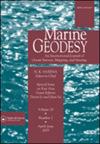Validating a New GNSS-Based Sea Level Instrument (CalNaGeo) at Senetosa Cape
IF 1.4
4区 地球科学
Q2 GEOCHEMISTRY & GEOPHYSICS
引用次数: 4
Abstract
Abstract The geodetic Corsica site was set up in 1998 in order to perform altimeter calibration of the TOPEX/Poseidon (T/P) mission and subsequently, Jason-1, OSTM/Jason-2, Jason-3 and more recently Sentinel-6 Michael Freilich (launched on November, 21 2020). The aim of the present study held in June 2015 is to validate a recently developed GNSS-based sea level instrument (called CalNaGeo) that is designed with the intention to map Sea Surface Heights (SSH) over large areas. This has been undertaken using the well-defined geodetic infrastructure deployed at Senetosa Cape, and involved the estimation of the stability of the waterline (and thus the instantaneous separation of a GNSS antenna from water level) as a function of the velocity at which the instrument is towed. The results show a largely linear relationship which is approximately 1 mm/(m/s) up to a maximum practical towing speed of ∼10 knots (∼5 m/s). By comparing to the existing “geoid” map, it is also demonstrated that CalNaGeo can measure a sea surface slope with a precision better than 1 mm/km (∼2.5% of the physical slope). Different processing techniques are used and compared including GNSS Precise Point Positioning (PPP, where the goal is to extend SSH mapping far from coastal GNSS reference stations) showing an agreement at the 1-2 cm level.在塞内托萨角验证基于gnss的新海平面仪(CalNaGeo)
科西嘉测量站建立于1998年,目的是对TOPEX/Poseidon (T/P)任务以及随后的Jason-1、OSTM/Jason-2、Jason-3和最近的Sentinel-6 Michael Freilich(于2020年11月21日发射)进行高度计校准。本研究于2015年6月进行,目的是验证最近开发的基于gnss的海平面仪器(称为CalNaGeo),该仪器旨在绘制大面积的海面高度(SSH)。这是使用部署在塞内托萨角的定义明确的大地测量基础设施进行的,并涉及估计水线的稳定性(因此GNSS天线与水位的瞬时分离),作为仪器拖曳速度的函数。结果显示了一个很大程度上的线性关系,大约为1毫米/(米/秒),直到最大实际拖曳速度为~ 10节(~ 5米/秒)。通过与现有的“大地水准面”地图进行比较,还证明CalNaGeo可以以优于1 mm/km(物理坡度的约2.5%)的精度测量海面坡度。使用并比较了不同的处理技术,包括GNSS精确点定位(PPP,其目标是将SSH映射扩展到远离沿海GNSS参考站的地方),显示出1-2厘米水平的一致性。
本文章由计算机程序翻译,如有差异,请以英文原文为准。
求助全文
约1分钟内获得全文
求助全文
来源期刊

Marine Geodesy
地学-地球化学与地球物理
CiteScore
4.10
自引率
6.20%
发文量
27
审稿时长
>12 weeks
期刊介绍:
The aim of Marine Geodesy is to stimulate progress in ocean surveys, mapping, and remote sensing by promoting problem-oriented research in the marine and coastal environment.
The journal will consider articles on the following topics:
topography and mapping;
satellite altimetry;
bathymetry;
positioning;
precise navigation;
boundary demarcation and determination;
tsunamis;
plate/tectonics;
geoid determination;
hydrographic and oceanographic observations;
acoustics and space instrumentation;
ground truth;
system calibration and validation;
geographic information systems.
 求助内容:
求助内容: 应助结果提醒方式:
应助结果提醒方式:


